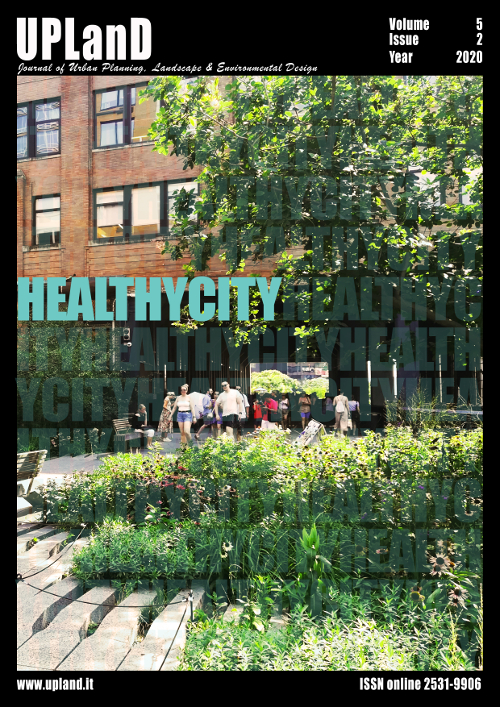Temporary inhabitants in a new post-COVID 19 city
Main Article Content
Abstract
The contemporary world, highly connected and globalized, is interwoven with various opportunities and weaknesses. Cities are crossed by new massive migratory flows due to various reasons, which have their roots in the economic, social, geopolitical dimensions, and then again due to the effects of climate change and health emergencies. Moreover, just in a traumatic way, we found ourselves facing a health crisis caused by the
COVID 19 pandemic, which exploded between the end of 2019, first in China and then spread globally in the early months of 2020, which still unfolds its unpredictable effects. What role do cities play in these events? How have they changed and how will they change again? It will happen this time, as in the past, that urban planning actions and choices will make a decisive contribution to resolving the health crisis, providing facilities such as parks, broad avenues, sewer networks? So giving a new meaning to the statement "the shape [of the city] follows the infection" (Bernardi, magazine Cielo Terra 2020).
The lockdown phase has experienced a delay in the use of smart working, which was already a distinctive feature of the lifestyles of the knowledge workers, leading to the coincidence between workspace and living space, which already new housing models such as co-working had tried mainly out.
The paper, starting from research developed in the Dicar of the Polytechnic of Bari, on new residential models for temporary inhabitants (city users, students, creatives, buyers and tourists), intends to question how the post-COVID phase can lead to a reinterpretation of these [new] models, but already not entirely adequate to interpret this phase of further crisis.
Downloads
Article Details

This work is licensed under a Creative Commons Attribution-NonCommercial-NoDerivatives 4.0 International License.
Authors who publish with this journal agree to the following terms:- Authors retain copyright and grant the journal right of first publication with the work simultaneously licensed under a Creative Commons Attribution License that allows others to share the work with an acknowledgement of the work's authorship and initial publication in this journal.
- Authors are able to enter into separate, additional contractual arrangements for the non-exclusive distribution of the journal's published version of the work (e.g., post it to an institutional repository or publish it in a book), with an acknowledgement of its initial publication in this journal.
- Authors are permitted and encouraged to post their work online (e.g., in institutional repositories or on their website) prior to and during the submission process, as it can lead to productive exchanges, as well as earlier and greater citation of published work (See The Effect of Open Access).
References
Bagnara, S. (2010). Lavoro e sistemi formativi nella società della conoscenza, Fondazione Agnelli, Working paper.
Balducci, A. (2010-2011). Territori post-metropolitani come forme urbane emergenti: le sfide della sostenibilità, abitabilità e governabilità, Milano.
Bauman, Z. (1999). Modernità liquida. Bari, IT: Editori Laterza.
Bernardi, V. (2020). “Emergenza pandemia, ma dov’è finita l’architettura?”, Cielo Terra 2020
Bologna, S. (2005). L'ospite ingrato, VIII, I, 2005, p. 18.
Bologna, S. (2015). Knowledge workers, dall’operaio massa al freelence. Trieste, IT: Asterios editore.
Bonomi, A., & Abruzzese, A. (2004). La città infinita, Milano, IT: Mondadori.
Korby, M. (2019). Nuove forme dell’abitare, tesi dottorato Dicar - Poliba, Bari
Latour, B. (2020). La sfida di Gaia, Roma, IT: Meltemi.
Levy, B. H. (2020). “La pandemia e l’altro pianeta”, in La Repubblica, 9 maggio 2020
Mastropietro, E. (2013). L'Europa progetta la città. Politiche e pratiche di riqualificazione urbana. Milano, IT: Mimesis.
Martinotti, G. (1993). Metropoli. La nuova morfologia sociale della città. Bologna, IT: il Mulino.
Martinotti, G. (2019). Sei lezioni sulla città. Milano, IT: Feltrinelli.
Molinari, L. (2020). Le case che saremo: abitare dopo il lockdown. Milano, IT: nottetempo.
Secchi, B. (2016). La città dei ricchi e la città dei poveri. Roma, IT: editori Laterza.
Soja, E., (2000). Postmetropolis Critical Studies of cities and regions. New York, US: Wiley Blackwell.
Urry, J. R. (1995). Consuming places. Hove, IT: Psychology Press.
Ratti, C. (2020). “Le Università sono dinosauri”. Open - 22 maggio 2020

